By: Thorsten Overgaard. June 14, 2013. Updated November 1, 2022.
Add to Flipboard Magazine.
As a photo competition judge I occasionally get asked, "What do you look for?” In this article I will give you an idea.
I have always avoided putting myself in a position where I had to be judged by others or had to get praise or approval from others. If I knew it was good enough, that was what counted.
In the "old days" however, before self-publishing, the Internet and having an established name, that was a problem. You couldn't get a photo, an article or a book published without going via an editor. If you wanted to make and sell music you had to get approved by a record label.
In school you had to get the teachers approval that your work was good enough. I remember getting criticized for my writings in school till I was 17. But then when I went to business school, my teacher there was so enthusiastic about my writings that he read my work to the whole class.
Different viewpoints; different opinions.
But I always knew my own voice, myself.
Being the one judging others’ work
Participating in photo competitions is something that - naturally - never felt natural to me.
It can be tough training to edit your images down to a handful or just one to submit. It involves trying to understand other people’s images and how they are judged alongside yours.
I see some people who are really good in selecting images and submitting them to competitions. They have fun with it as if it’s a sport or a way to spice up one’s photography.
But how does one take that lighthearted stance and go about winning a photo competition?
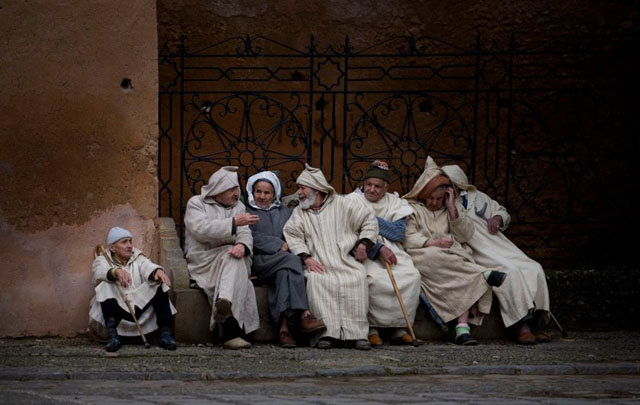
Winner of the Maybank Photography Awards 2012 in the category Street. "The Old Men of Marocco" by Chau Sau Khiang.
How to Win Photo Competitions
Part of my Overgaard New Inspiration Photography Extension Course I is a drill where the participants must select their work to participate in a photo competition. The point is to use one's work for something, and to be able to see one's work with the eyes of others..
It's not that I am one of those who are good at winning photo competitions, because like I said, I never really liked the idea of asking others for their opinion. But now I happen to judge photo competitions, and that has given me an insight I don't mind sharing. I find that being a judge has actually opened my eyes to the fact that this is just another way of sharing images.
I also happen to know that a great deal of people "check me out" as the judge when they enter a competition. They try to understand what I might like.
My experience as a judge also made me realize that participating in photo competitions is actually a healthy exercise in reviewing, editing and presenting ones own work. So I have participated in the Oskar Barnack Award for the first time ever.
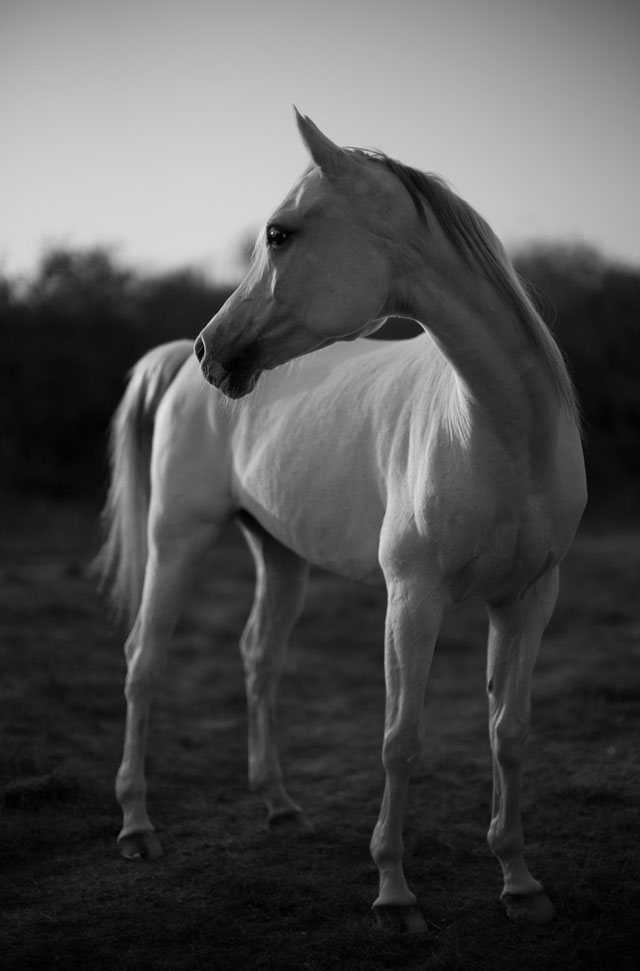
One of my 10 images in the series "WRITING LIGHT LETTERS BY MOON LIGHT" for The Leica Oskar Barnack Award 2013. In retrospect I would have refined the series to fewer pictures. I will recommend that one select images for a sumbission some time in advance, review it every two days to refine it. You change your view a lot and become more critical as you revisit and look at your selection.
I didn't win the competition, but I did win the pleasure of learning to be on the other side.
The process of editing down a set of images to match a competition is very interesting and something one can learn a lot from - winning or not winning.
Of course you always hope. You have to. That's part of participating, even though it can feel like a lottery. Maybe you win, maybe you don’t.
The soul of a competition, and the judges' view
You always have an audience, and they have different viewpoints. What your mother likes and dislikes in your photographs is not necessarily the same as the folks at a photo forum.
Generally my philosophy is to do what you feel is right yourself, and then find an audience that agrees.
But in photo competitions - and that is the beauty of participating - you limit yourself by selecting a small piece of your own work that might please a small audience of judges that most likely have a tradition for liking certain things.
Here’s a few examples of current photography competions:
The World Press Photo Award has different categories, but one can get the sense that it has to be a certain way. Portraits of people have to have an edge; they have to have lost an arm, sell their body to twisted tourists in a third-world country or they are well-known actors who are now dead (of cancer or AIDS preferably). The winning picture of a World Press Photo Award is seldom a picture people want to buy and hang on their wall, unless they work in the press.
(National press photo competitions are usually on a lower level generally than World Press -naturally - but mostly the tone is the same.)
The Al-Thani Award for Photography was a Qatar-based competition. If one participates one gets the book with winners and shortlisted photographs. The style here was very poetic and the aesthetics in the photos can be very polished and colorful (without Photoshop, but mostly with a lot of Photoshop).
The Oskar Barnack Award has changed over the last few years. It used to be very dark and painful winners, preferably grainy and blurred. The recent years the winners have been quite different stories that seem to have uniqueness as the keyword. Winning styles have a unique idea, a unique location, a unique way of telling a news story, and similar.
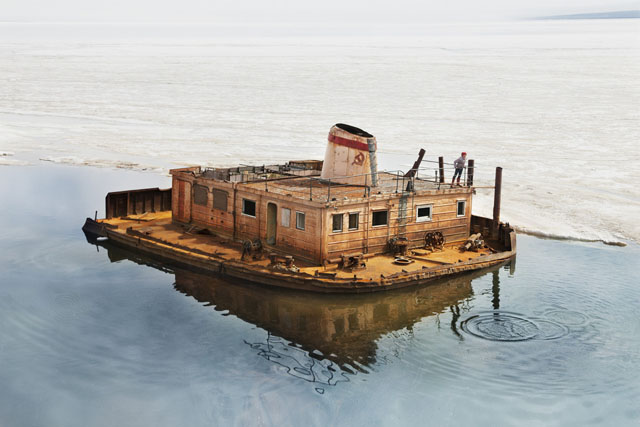
Winner of the Leica Oskar Barnack Award 2013, Evgenia Arbugaeva, Russia
The Taylor Wessing Photographic Portrait Prize This is an almost random photo award I found via the https://www.workshopx.org/eng/calendar which is an overview of upcoming photo competitions around the world, as well as submitting work to exhibitions and books.
The style of the previous winners of this competition are more artsy. They fit in a museum gallery, on a wall to be viewed. Still portraits, statements, are all very natural made (could be straight from a slide film shot using natural light).
The I-SHOT-IT.COM I judged as lead judge for more than ten years since it started in 2011. The are two main competitions; a quarterly geneeral competition and a quarterly black & white competition; and then there are other categories also such as pets, mobile photos, etc. it is an international competition with ongoing competitions in many categories and where the submitted photos - as well as the winners - can be seen online. The style of the winning pictures could be said to be what photographers would photograph of everyday life, not art photographs. What I prided myself of as a judge of this brad competition was that we as judges didn't know the story, the name of the photographers, the make of the camera, and not even the year or location. In this competition the photo has to do the work. Your skin color, if you are a man or a woman, if you are poor or richy, and so on: It's the photo only that is judged.
After being lead judge there for more than ten years, I moved on to the international World Photo Compeition where it is exactly the same rule: The photo has to do the work.
The Pulitzer Prize for Photography is one of the most prestigious awards for photographers, often historic events, and usually "news drama" type events.
International Color Awards is an international compeition for color photos only.
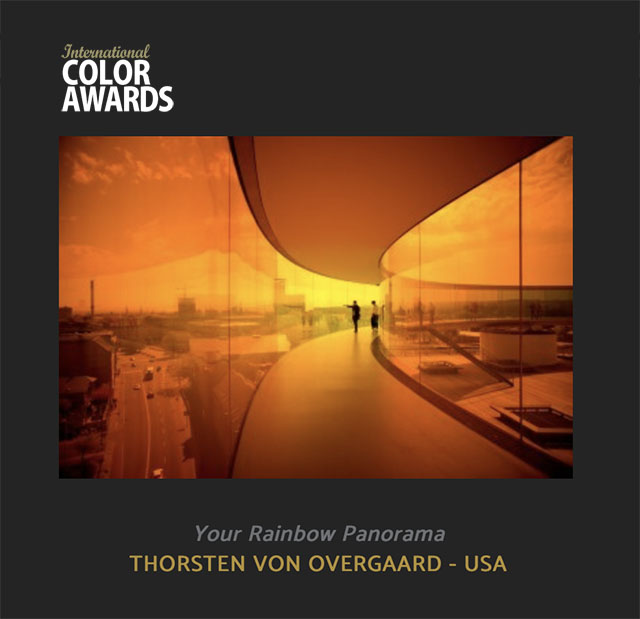
Winner in architecture, International Color Awards, 2021.
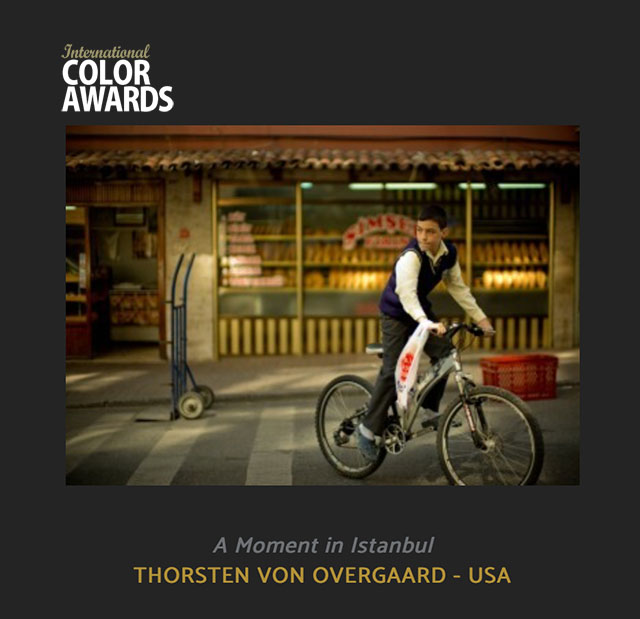
Winner in Children of the World, International Color Awards, 2021.
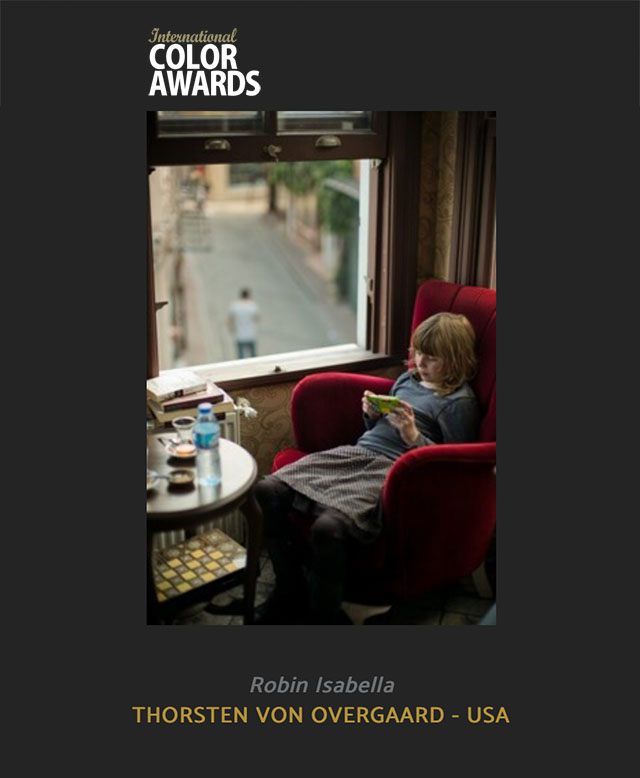
Winner in Children of the World, International Color Awards, 2021.
The International Photoraphy Awards (IPA) is different competitions like Budapest International Photo Awards (BIPA), Tokyo International Photo Awards (TIFA), etc. I've participated a few times and won gold, silver, bronce, etc.

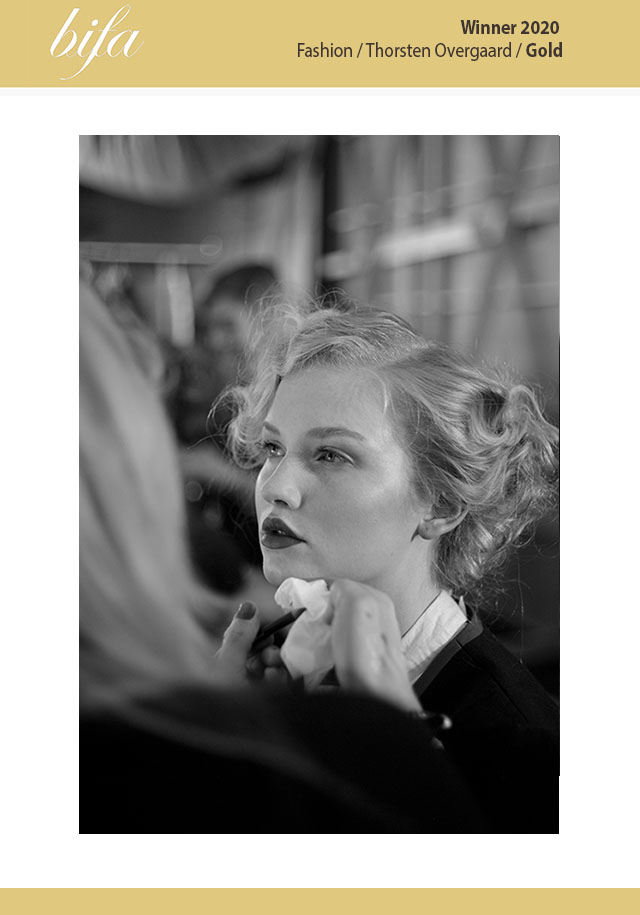
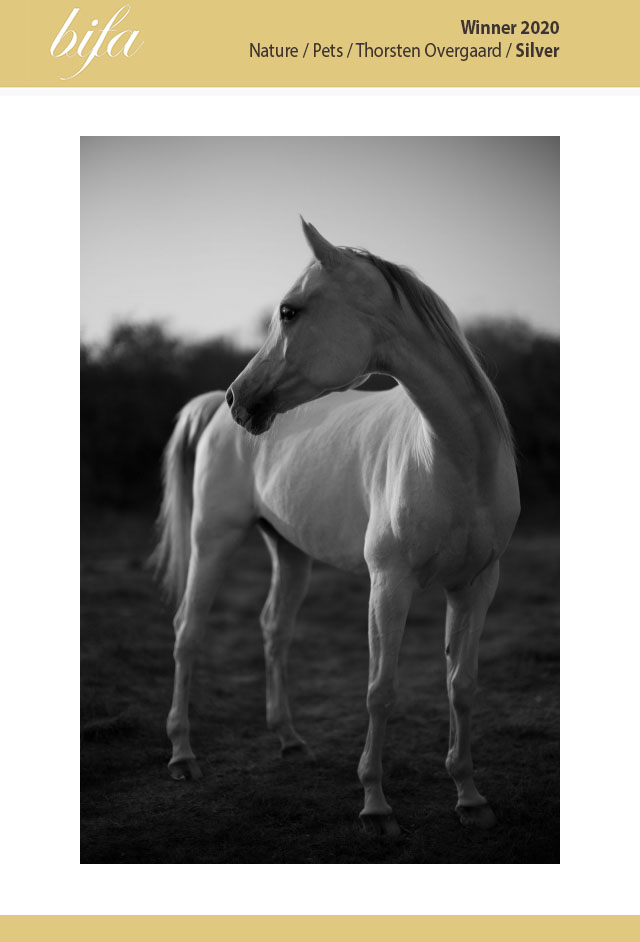
Do you fit in?
So, each photo competition has it's own soul and style. Just like people have different tastes, photo competitions have different tastes.
The first and obvious question in deciding to participate in one or the other competition to ask is:
“Do I have some images in a style that would fit in?”
Some competitions are limited to a certain geographical area, a certain time period, and a narrow theme or similar. Sometimes that rules you out. Spend some time looking at the previous winners and the overall style, then decide if you would and could win. If not, find another one.
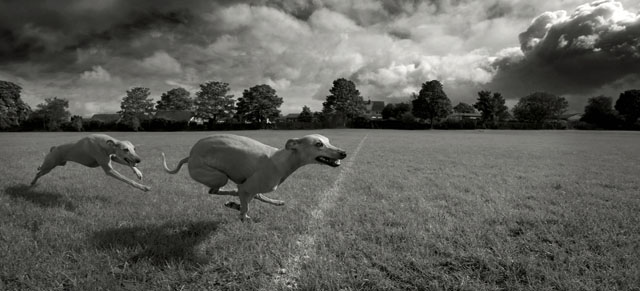
Winner of a Leica V-Lux camera and $1,200 cash award in the I-SHOT-IT.COM Dog Photo Competition May 2013. By Bob Patrefield, UK.
You have to select images amongst your work that fit that competition. Not the photos you like the best, but the photos in your portfolio that would suite that competition.
I think it is very important to distinguish that what you create and like is not bad, just because somebody else doesn't get it. It just means they didn't get it.
The whole idea with art is to make something original and surprise and please others by the level of communication, the thinking, and the aesthetics. As such, it has to be above level, and that is why you don't ask people what they want.
But in the case of photo competitions, you select amongst the work you already have done.
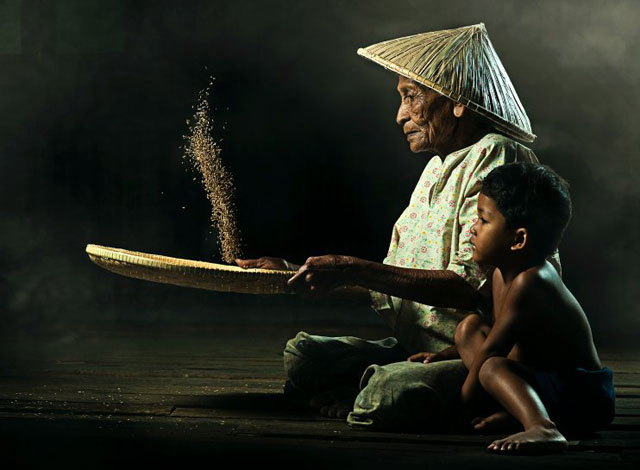
Winner of the Maybank Photogarhy Awards 2012, by Muhamad Seleh Bin Dollah.
The winning picture
A winner is easy to recognize once you have it.
One way of finding the winner(s) is simply to look through the submitted images, as if it were one photographer’s pictures. "Amongst 2,500 images this person has here, which one is the absolute best?" It is surprising how easy it is if you not view it as 2,500 individual images, but as one portfolio. You finally end up with a shortlist, and then a final winner.
Other people who do the same would come up with an almost similar result.
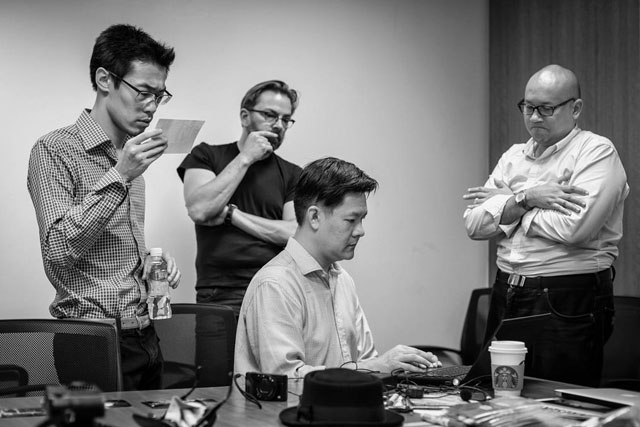
Ming Thein and Thorsten Overgaard judging the Maybank Photography Awards. Photo by Ming Thein.
What do judges look for?
It surprises me how similar peoples tastes are. When I judge with other judges, the absolute shortlist will be very similar and one can agree on a final winner by flipping through and judging different details.
Judges and people will have certain things they think is important, but apart from that, a winning picture is obvious. Almost something you can measure.
Of course, what you can't know as an outsider is if the judges want to “do something different this year” or decided to favor female photographers this year or something of that sort.
It could also be that an image is politically incorrect, too kinky, or too nude. It's a winner, except it can't be a winner. In other competitions that would be the reason it won, because it was controversial.
These are the unknowns in a photo competition, and they are part of the beauty.
Some judges I have worked with were keen that a photograph had to show that the person knows the technique of photography.
I don't agree. For me a photo competition is about the photo, not the photographer. If the photo is good, it basically doesn't matter whether the photographer knew how to do it or was just lucky.
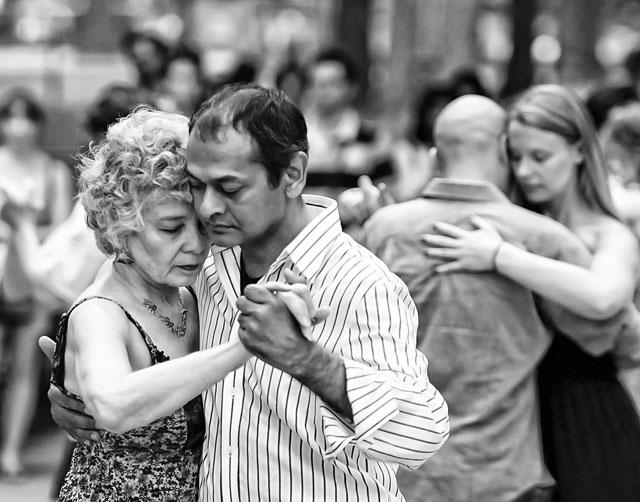
Winner of the I-SHOT-IT.COM first prize of $4,625 in the Premium Competition, 4th Quarter 2011. By Harold Blum, Chicago
Presentation
Some photo competitions allow a title or caption; some want a short bio, some can look at which camera was used and such.
In the I-SHOT-IT.COM the judges does not know anything about the camera, the photographer or where and when the photo was taken. The only thing is the image, and only one image.
In The Oskar Barnack Award you submit a bio, titles and a description. You submit a series of images that have to work as a series. But even a series has a main shot that defines the series and is in itself strong enought to be a winner.
This means that you have to think in presentation. What do the judges’ see when they look at your submission?
Finish the image
Consider the image you submit the final word. What you submit must tell the whole story, and in the case of one image, that image must tell it all without subtitles or any description. In the case of a series of images with a description, the 'package' must work as such.
In some photo competitions the judges may ask for a final file (for a book project, art exhibition, etc), which will give you the possibility for polishing the image. But in most competitions the image you submit is the final one.
Hence you should pay attention to details and not submit and an “almost” image. A winner is never “almost” good enough; it is always a finished image.
Think in presentation
First impression is important. What will make the desired impact? Which one, in a series of images, should be the first the judges sees? What should the sequence be? Which paper should I use (if prints are submitted), and should it be glued onto a cardboard or put in a fancy box?
Also important to pay attention to the basic things such as submitting the correct size file and not a stamp-size image. Of course it will make a difference if the image is so small that the judge can't really see it, or the conversion to the final file format was done so the colors or sharpness changed.
What will the judges be looking at is ... simply what they see.
It is not easy. Many very experienced photographers have a photo they thought was just ordinary, but in the hands of a picture editor and a layouter, when used over two pages with headline and all, suddenly was an award-winning historic image.
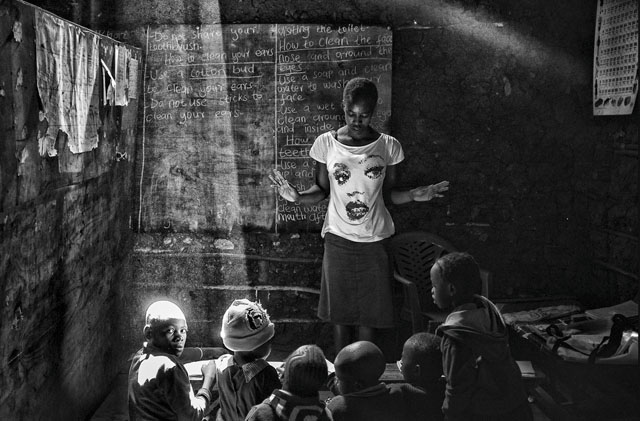
Winner of a Leica M Monochrom camera and a cash award of $25,370,, the winner of the I-SHOT-IT.COM black and white compeition in April 2013. By Luc "Velu" Vekemans, Belgium
A great picture
A great picture is simply a great picture. When you see it, you know. And usually, the longer and more you look, the more certain you are that it is a great picture.
When I look at past winners in I-SHOT-IT.COM some things are alike:
The image is self-explaining. It is all in the picture. It is final. A self-contained package.
The winning images tend to be natural images that just happened. They are not prepared, staged, planned or created. The photographer didn’t "try really hard" to create it. The winners often look like a great photo that a person with a camera and knowledge on how to use it, stumbled into. And got it.
The winning picture is often unusual in the sense that it is extraordinary. Extraordinary lucky, extraordinary location, extraordinary light, extraordinary something. Never ordinary.
The winner is aesthetic and has originality and an idea to it.
The winning picture has an immediate appeal, sometimes a Wow! It can be the photo overall, or simply the beautiful colors or tones. Upon a closer inspection the image will have a deeper appeal, as well.
The winning picture interacts and becomes better the more you look at it. It is still a winner after a week.
The winning image often has interaction with the viewer. You can keep finding things in it, put possible future and past stories into it. It makes you wonder. You become part of the images’ story.
The winning picture is not necessarily perfect. It just has that something that makes you like it more than others.
Often the winning image would be suitable for a poster, postcard, and a framed print on a wall. An item you would want to look at again and again
Often, if a winning picture were a book cover, you would want to pick that book up and have a look at it. It has that quality.
The image has relevance to the competition it is in and the present time.
This is for I-SHOT-IT.COM and if you analyze winners of other competitions, you may define similarities for the winning images. It is quite interesting to do if you focus on the similar qualities.
The best picture win
Some times I hear people complain that the winner is a professional photographer, travels more, have better opportunities, better equipment and so on.
The basic principle in compeotions is that the best wins. No compeitions are about finding and awarding the ones who have the hardes conditions or the least opportunities. Compeitions are competitive, they are not based on Marxism or arranged for you to feel better about your photography.
If you think it is unfair, think again: It is the picture that wins, not the equipment or the name of the photographer. In a compaition as I-SHOT-IT.COM the best picture wins, even it is the only one you ever made, and even if it was the first or only you ever took. If the image is the best, it wins, even if others may have made many almost as good pictures throughout a lifelong career. It's the picture!
It's like the olympics. If you have a good day and the other's doesn't have a better day, you will win. If you did it again tomorrow, the other might win because he had a slighly better day.
If anything, professional photographers takes many photos, that alone means there might be more to choose from than the weekend-shooter. Also, the oprofessional photographer is used to getting them judged by clients and editors, so they have an idea which photos might work best on others.
A picture that does not win
A picture that raises more questions than answers can't make it, at least not in a competition where there are no explanations allowed. When the judge starts to question your photo, it's out.
In short, you could say that what disqualifies - in my view - is when a photo is incomplete, questionable and too good to be true. For example:
Photoshopped to a degree where you can't tell if it is real or not, but pretending to be a photograph. If I have to analyze it to find out if it is a photograph made into a drawing or pieced together to falsely look as one photo, I question the photo. So it is not qualified to win.
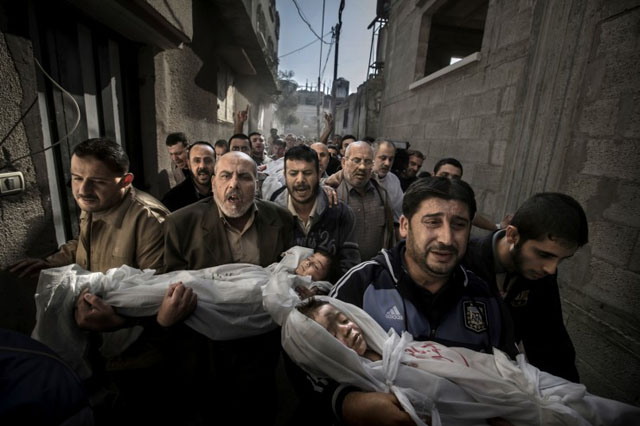
If we look at The World Press Photo 2013, the winner in that raised that question "Is it made-up, is it fake?" by many. Yet it won World Press. I would have ruled it out as trying too hard. I would question if it was made up partly or completely, and I don't like the message. But that is another competition, so other viewpoints apply. Keep this in mind. What I say here is my opinion and guideline, not the truth for every photo competition.
Some photos are so lucky, it can't be real. Is this a film set, a scanning from a book or what is it? Like ten white horses on a beach with the men and women dressed in 18th century clothing… this can't be a normal photograph (incomplete understanding).
A staged photo doesn’t really work. I'm not ruling it out, but based on experience, the photos I like have something natural to them. They happened in real life.
Weird, twisted messages don’t really work unless the point exactly is that the image is not explained. But then that idea would be implied in the image itself, not left open.
Pictures of others art doesn't work. You can’t rely on the idea of a sculpture, a building or painting/poster as your photo. If you can add something to it, there's a chance.

Don't rely on others art and ideas to make your photo. This it is the "Your Rainbow Panorama" by Olafur Eliasson on top of the ARoS International Art Museum in Denmark. In my opinion the sculpture (as it is) makes the photo more than the photographer (which happens to be me, so I can say so without insulting anybody).
A picture that doesn't communicate immediately, doesn't win. There has to be some element that catches the attention. The whole image does not have to be laid out in the first instant, but there has to be something that draws you in.
Pointless pictures without story or anything, glide by. Yes, it may be a pretty colors, or a nice cloud or you got it rally nice and sharp. But if there are not eyes looking straight at you from the image, or an interesting pattern in an else seemingly even green field, it doesn't stop the viewer to learn more.
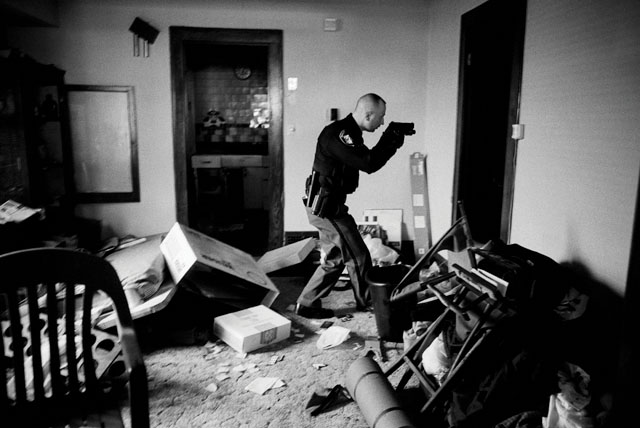
One of my favorites is the The World Press Photo Award winner 2008 that was taken with by Anthony Suau with a Leica M6 TTL and 28mm. It is a really strong image when you know the context. As an image itself it raises more questions than it answers. But in the World Press Photo context, where a subtitle is part of what you submit, and as a news photo, hands down one of the best photos I have seen, considering the year 2008 and the story behind:
"The picture shows an armed officer of the Cuyahoga County Sheriff's Department moving through a home in Cleveland, Ohio, following eviction as a result of mortgage foreclosure. Officers have to ensure that the house is clear of weapons and that the residents have moved out."
| |
|
|
|
 |
| |
Buy the Best-Selling eBook by Thorsten Overgaard:
"Finding the Magic of Light"
"I have just been reading your eBook last night, which opened my eyes for more than
I have been thinking about before. You have a great sensitivity that I feel
connected with, and I enjoyed every word."
"I am reading your book, Finding the Magic of Light. Exactly what I crave."
"I find your books very helpful and thought-provoking."
"A must have. Personally useful for street photography."
|
 |
|
|
|
| |
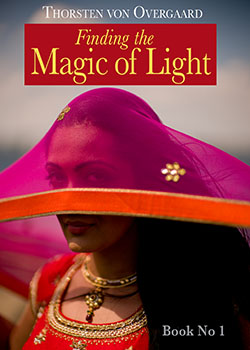
Also available in German:
"Die Magie des Lichts Finden"
 DE DE |
|
In this easy to read and apply eBook, Thorsten Overgaard takes you on a journey to see, understand and simply use light.
"One of the most important ways to get an aesthetic and pleasant picture is to find the good light."
"Finding the Magic of Light"
New 2nd edition (April 2015)
eBook for computer and iPad.
(87 pages)
Only $47


Order now - Instant delivery.
(Note: If you bought the first edition of this book, this new edition is free. Simply send an e-mail for your free update).
★
★
★
★
★
★
|
| |
|
|
|
The most common error: "See, I got it!"
The most common error I see is the "I got it!" factor. That is when you look at an image of a bird in a tree and nothing of interest jumps out of the picture. It is not even a rare bird, but the result of a photographer who was so happy he got the bird in focus that he submitted it to a competition.
There are a lot of images that falls into this "I got it!" category. The eyes in focus in an otherwise bad portrait, a car frozen in an image, a hummingbird frozen in an else not very well-composed image.
There is nothing wrong in "I got it!" if so many other elements fall in place as well. Composition, a minimum of technical quality, something that draws you into the image. Those things, and more, all add up to a good photo.
And if one look at the winning pictures, quite a lot of elements have fallen in place, and either very few things or nothing at all is wrong. "I got it" is just one small element of many.
It takes a lot of things right to be the best amongst 500 or 30,000 submitted images in a competition.
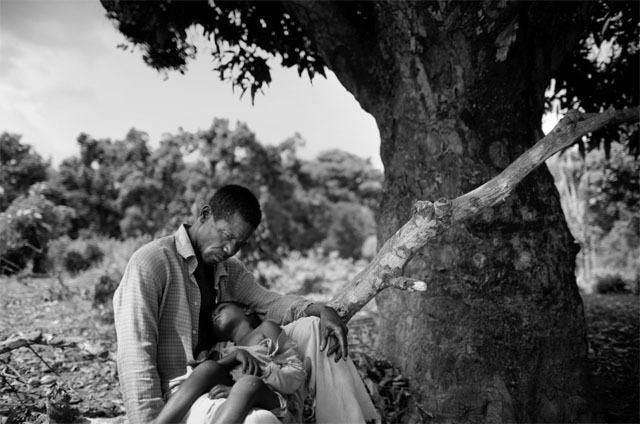
Winner of a Leica M Monochrom camera and a $5,000 cash prize in the I-SHOT-IT.COM competition January 2013, a photo by Jan Garup, Denmark.
Luck
Some times you are unlucky that you have a winning image, there just happens to be another with an even better winning picture in the same competition.
If he or she hadn't been there, perhaps you would have won. It can be that close.
Photo competitions as your business plan
If you have a winning photo it can win one or many competitions. It's both the photo(s) and your ability to select photos that counts.
In the Maybank photo competition (which is a yearly competition held by Maybank in Malaysia and Singapore) we realized the winner in one category was also winner or runner-up in a National Geographic competition. And not only that; he also was the winner in another of the Maybank categories!
"But he already won!" you could say, implying that one can only win, once. But not so: Photos are not lottery tickets that can only win one jackpot.
You will notice that often winning photos in one competition also win in others. That’s because they are actually great photos.
For example, the Oskar Barnack Award 2011 by Jan Grarup also won several other competitions. And Jan Grarup won the I-SHOT-IT.COM black & white competition for another of his photos. Interestingly enough he also submitted other well-known photos in the same competition, but it was this one that won.
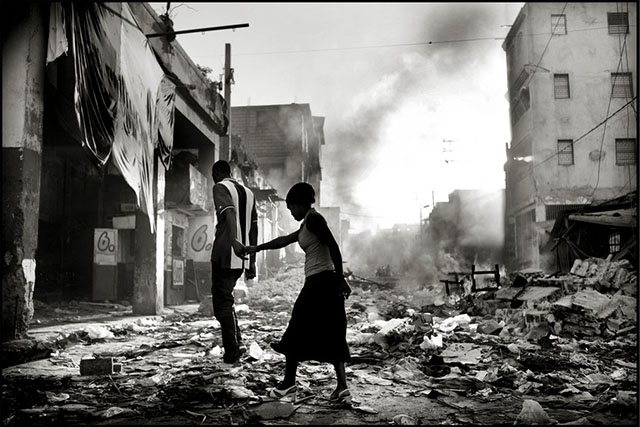
Jan Grarup's "The There Was Silence" fron the haiti earthquake aftermath won the Oskar Barnack Award and several other competitions he submitted it to. He know he got a winner, so he submit it all around. No reason to invent something new. Use what you already know you got.
I learned this from Jan Grarup
I took notice of Jan Grarup and made my own selection of 15-20 photos, and then I made a list of photo competitions to participate in. I looked at what style of photographs had won previously, and if it was something that looked far away from what I do, I would cross them out.
The ones I felt matched, I would submit from my selection, the ones I felt could win, in the categories offered. It took me 3-4 hours to make my selection back in August 2017, and pick three photo competitions, and then I submitted. I managed to win one and get two honorable mentionings in another one during October and November 2017:
Winning the APA Award 2017
My picture "Shadowland" won the category Photojournalism in the prestigious international competition by American Photographic Artists.

Honorable Mentioning IPA Awards 2017
Two of my pictures, "Shadowland" and "White Horse" won Honorable Mentioning in IPA Awards 2017 - Photographer of the Year competition.
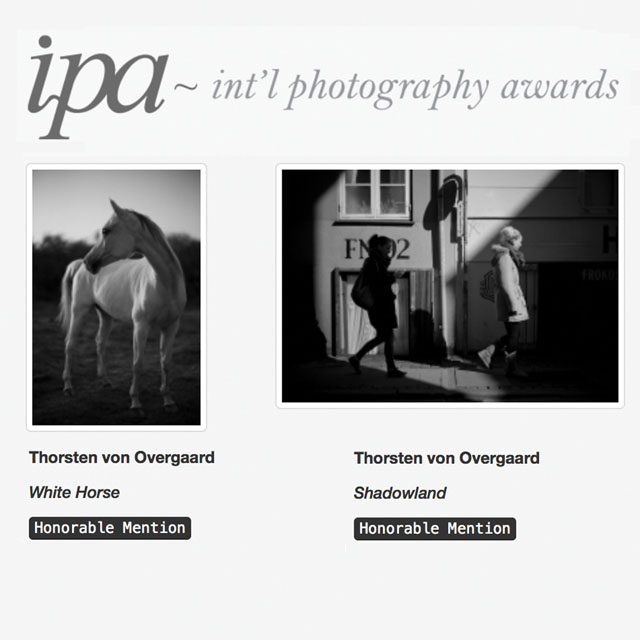
Two photographs by Thorsten Overgaard , "Shadowland" and "White Horse" won Honorable Mentioning in IPA Awards 2017 - Photographer of the Year competition.
Black Box Gallery 2019
From time to time, I submit for competitions. When I do, I usually select a small portfolio and submit it to a handfull of competitions that looks like the ones that would like my type of photography. Here's a photo from Portugal I did in 2018 that I submitted to several competitions this year. So far, the Black Box Gallery selected it for part of their jured exhibition:
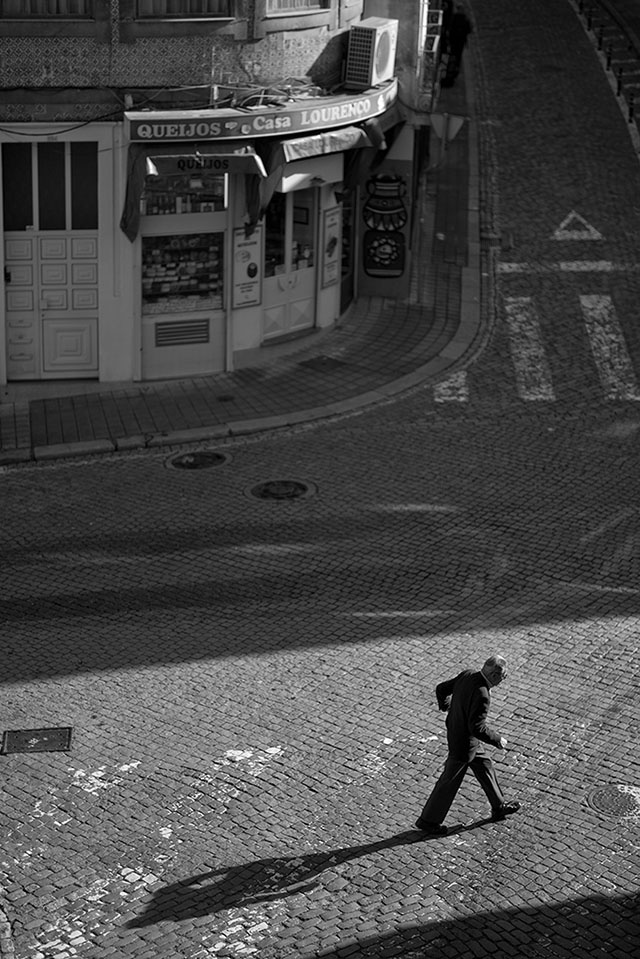
Selectred by the jury for the exhibition at Black Box Gallery; my Portugal photo from 2018. Leica M10 with Leica 75mm Noctilux-M ASPH f/1.25. © Thorsten Overgaard.
Bragging rights
By the time you have made a selection of "my most possible winners" and you start seeing the logics in submitting the right ones to the right places, there is not much to it. It's when you insist on others seeing the brilliance in something they don't recognize, you get into problems.
The first win is the ability to judge your own works with other's eyes. Once you can select winners and make them win, you got that.
The second thing you get is the bragging rights. I just bragged with my two winners above, and I made sure to have good graphics to show that I won this. You may use that to convince future clients you're a heck of a photographer by posting it on your website. Some who wins a lot have all the 20-30 logos of competitions they won on their website. Impressive. In any case, I feel it is important for one self to have something to show for it. "See kids, this is what dad does at the office" sort of thing. Something to hold onto to impress your grandchildren.
Of course, if the competition has a great cash prize, or other valuable awards, you get that too.
Judging well-known photos
As a judge you will stumble into pictures you already know, either because the image is well known or you happened to have seen it before on Facebook, Flickr or some other place.
The good thing is that the first thing you notice in a picture when you see it, is if it works on you. If it does, you look closer. If it doesn't, then it doesn't matter why.
Some times a well-known photo that had a great effect on you the first many times you saw it, just doesn't matter anymore. There are also some photos that are relevant for the time and age, but three years later they are not that powerful.
In other words, you don't have to worry about the celebrity-factor of being in a competition with bigger names than yourself. It is the pictures that make the impression, not who did it.
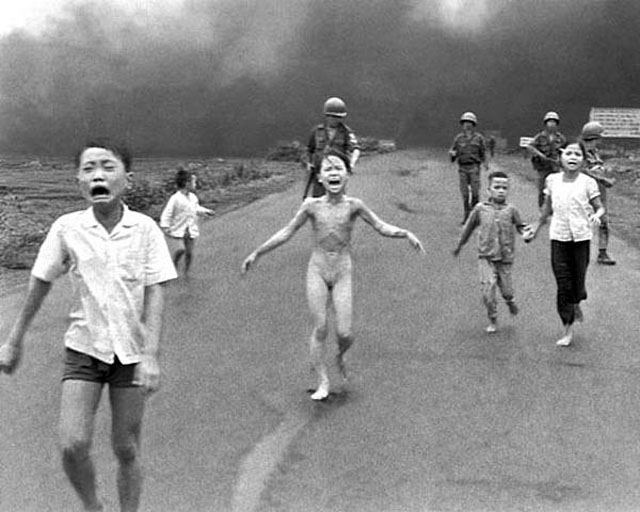
One of the strongest and most influental photos ever taken, yet it wouldn't be able to win a photo competition today, unless the competition was about the best historic image or similar. An image has to have relevance to the competition it is in.
World Press Winner Photo of the year 1972 and winner of the Pulitzer prize, by Nick Ut. After June 9, 1972 this image changed the worlds view on the Vietnam War.
Fairness
I think the most important rule in competitions is "to treat everybody the same".
I think the basic sense of fairness is that one knows that ones photo(s) were viewed with the same eyes as all other photos in a competition.
That is prevented if one image is a small thumbnail, the next is a bird sitting in a boring tree and the next one is a full-screen image processed in perfect tones. So presenting finished images in proper quality where you have the viewer in mind - and his or hers experience - is very important. Presentation does play in, because you only get that instant first moment to sell the idea that your image is a winner.
No matter how much I would like for you to present your best, if you don't send it, there's nothing I can do. I can't call or e-mail you that if you do this and that it will better, or require you to send a larger or better file. You have to present it right, the first time.
Advertisment:

Technical quality
To start off from technical quality to "construct" a winning image is not advisable. The content of it is more important than the form.
Technical quality is good to exercise to a degree so you master it when there is something to photograph and tell. But mastering technical quality alone will not win the competition.
How the judges work
Most photo competitions will be judged by the judges individually, for the most part of the entries. Then a short-list will be discussed as a group judging and discussion. Only competitions with rather few images can possibly be judged with all the judges in the same room from start to end. And even then, the judges will go separately through the images and then meet again to discuss the best ones.
So most images will start off being seen by one person. If he or she likes it, it may be part of a final selection. As a judge you will have your own selection, and when you see the others' you will see how they overlap: Out of 10 perhaps 7 of them are also in the top-10 of the others.
In this video you can get an idea how the jury at the Leica Oskar Barnack Award 2013 Jury works with their shortlist.
The individual judges' personal reasons for liking an image, his or her personal preferences, and his or her abilities to sell that viewpoint is what makes the final winner. So if you make it to the shortlist, you also have a judge in favor for your picture.
On the other hand you have other judges that will criticize your image for not being sharp enough, not having the right crop, “it would have been better in black & white”, and any other possible scenario. Think of the Oscars, it is not always the most popular or the most beautiful that wins the awards. The judges personal preferences, political and cultural themes in the time and age play in as well. Sometimes a compeition want to stipulate that they are for womens rights, or against racism. I don't agree with that type of "political motivated" winners, but it does happen and you just shouldn't take it personal if your photo didn't fit into that theme.
But the judges will be open to other’s arguments. Perhaps a judge saw something interesting in another image, and by telling it, he made the other judges see that too. And that is how the final winner is found, if it’s not straight-out obvious.
May the force be with you!
How to find good photo competitions to participate in
To find photo competitions, visit the https://www.workshopx.org/eng/calendar for exhibitoon and photo competitions contests, or directories like the Photo Contest GURU and PhotoCompete for an overview. Or simply search Google for some.
There is usually national (and international) photo compeitions held by press photographer associations and other photograhy associations.
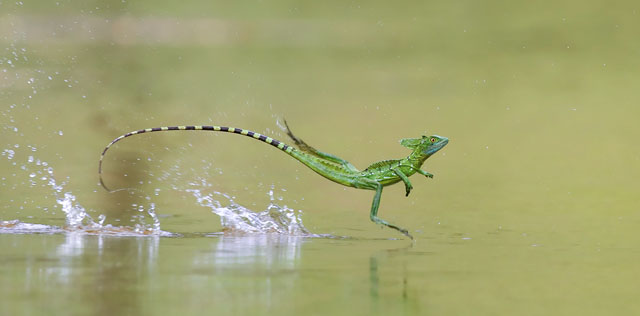
The winner of the I-SHOT-IT.COM Wildlife Competition 2013. By Bence Mate, Hungary.
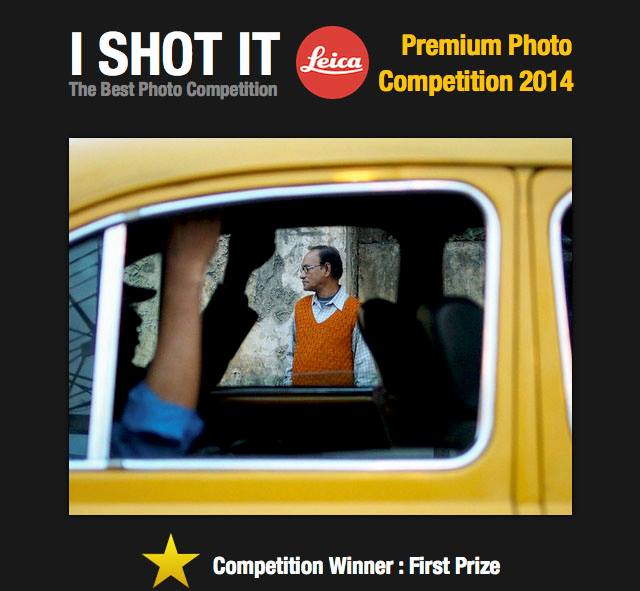
The winner of the I SHOT IT.COM competition, 1st Quarter 2014
![]()
